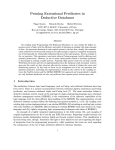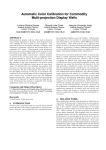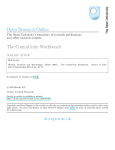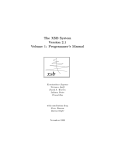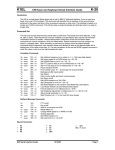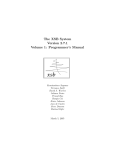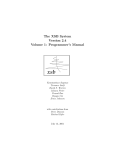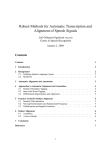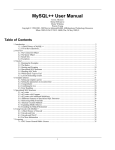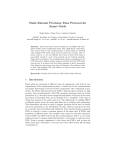Download PDF file
Transcript
Generic Cut Actions for
External Prolog Predicates
Tiago Soares, Ricardo Rocha, and Michel Ferreira
DCC-FC & LIACC
University of Porto, 4150-180 Porto, Portugal
Tel: (+351) 226078830, Fax: (+351) 226003654
{tiagosoares,ricroc,michel}@ncc.up.pt
Abstract. An interesting feature of current Prolog systems is the ability to define external Prolog predicates that can be written in other languages. However, an important drawback of these interfaces is the fact
that they lack some important features necessary to improve both the
efficiency and the transparent integration of the Prolog system and the
external predicates. Such an example is the cut operation. This operation
is used quite often in Prolog programs, both for efficiency and semantic preservation. However, its use after a call to an externally defined
predicate can have undesired effects. For example, if we have a pending
connection to another application, or if we have memory blocks allocated
by an external predicate, when a cut operation occurs, we may not be
able to perform generic destruct actions, such as closing the pending
connection or freeing the unnecessary memory. In this work, we propose
an extension of the interface architecture that allows to associate generic
user-defined functions with external predicates, in such a way that the
Prolog engine transparently executes them when a cut operation occurs.
We describe the implementation details of our proposal in the context of
the Yap Prolog system.
Keywords: Prolog Systems Implementation, External Modules, Pruning.
1
Introduction
Logic programming provides a high-level, declarative approach to programming.
Arguably, Prolog is the most popular logic programming language. Throughout its history, Prolog has demonstrated the potential of logic programming in
application areas such as Artificial Intelligence, Natural Language Processing,
Knowledge Based Systems, Database Management, or Expert Systems.
Prolog’s popularity was sparked by the success of the WAM [1] execution
model that has proved to be highly efficient for common computer architectures.
The success obtained with the WAM led to further improvements and extensions.
Such an example is the foreign-interface to other languages. An interesting feature of this interface is the ability to define external Prolog predicates that can
be written in other languages. These predicates can then be used to combine
Prolog with existing programs or libraries, thereby forming coupled systems; or
to implement certain critical operations that can speed up the execution. Since
most language implementations are linkable to C, a widely implemented interface
by most Prolog systems is a foreign-interface to the C language.
However, an important drawback of these interfaces is the fact that they lack
some important features necessary to improve both the efficiency and the transparent integration of the Prolog system and the external predicates. Consider,
for example, the cut operation. This operation is used quite often in Prolog programs, both for efficiency and semantic preservation. However, its use after a call
to an externally defined predicate can have undesired effects. For example, if we
have a pending connection to another application, or if we have memory blocks
allocated by the external predicate, when a cut operation occurs we may not be
able to perform generic destruct actions, such as closing the pending connection
or freeing the unnecessary memory.
In this work we focus on the transparent use of the cut operation over external
Prolog predicates. The motivation for this work appeared from the undesired
effects of the cut operation in the context of our previous work [2] on coupling
the Yap Prolog system [3] with the MySQL RDBMS [4], in order to obtain
a deductive database system that takes advantage of the YapTab [5] tabling
mechanism in a similar manner to the XSB system [6]. The effect of the cut
operation in this context is well-known and can be so significant that systems
such as XSB clearly state in the programmers’ manual that cut operations should
be used very carefully with relationally defined predicates [7]:
“The XSB-ODBC interface is limited to using 100 open cursors. When XSB
systems use database accesses in a complicated manner, management of open
cursors can be a problem due to the tuple-at-a-time access of databases from
Prolog, and due to leakage of cursors through cuts and throws.”
To solve the problem between cuts and external predicates we propose an extension of the interface architecture that allows to associate generic user-defined
functions with external predicates, in such a way that the Prolog engine transparently executes them when a cut operation occurs. With this functionality
we can thus use these generic functions to avoid the kind of problems discussed
above.
The idea of handling cuts transparently by setting actions to be executed
on cut is not completely new. Systems like Ciao Prolog [8] and SWI Prolog [9]
also provide support for external predicates with the possibility to set actions
to be executed on cut. Our approach innovates because it uses the choice point
data structure to easily detect when a cut operation occurs on externally defined
predicates, and thus from the user’s point of view, pruning standard predicates
or externally defined predicates is equivalent. We describe the implementation
details of our approach in the context of the Yap Prolog system and we use the
coupling interface between Yap and MySQL as a working example. As we shall
see, our implementation requires minor changes to the Yap engine and interface.
Despite the fact that we have chosen this particular system, we believe that our
approach can be easily incorporated in other Prolog systems that are also based
on the WAM execution model.
The remainder of the paper is organized as follows. First, we briefly describe the cut semantics of Prolog and the problem arising from its use to prune
external predicates. Next, we present the C language interface of Yap and its
implementation details. Then we describe the needed extension of the interface
architecture in order to deal with pruning for external predicates. At the end
we discuss some experimental results on the specific case of relational database
interfaces and outline some conclusions.
2
Pruning External Predicates
Cut is a system built-in predicate that is represented by the symbol ’!’. Its execution results in pruning all the branches to the right of the cut scope branch.
The cut scope branch starts at the current node and finishes at the node corresponding to the predicate containing the cut.
Figure 1 gives a general overview of cut semantics by illustrating the left to
right execution of an example with cuts. The query goal a(X) leads the computation to the first alternative of predicate a/1, where !(a) means a cut with
scope node a. If !(a) gets executed, all the right branches until the node corresponding to predicate a, inclusively, should be pruned. Predicate b(X) is then
called and suppose that it succeeds with its first alternative. Next, !(a) gets
executed and all the remaining alternatives for predicates a and b are pruned.
As a consequence, the nodes for a and b can be removed.
a(X) :- b(X), !, c(Y).
a(X) :- ...
a(X) :- ...
b(X) :- ...
b(X) :- ...
c(Y) :- ...
?- a(X).
root
a(X).
root
root
a
a
b(X),!(a),c(Y).
b
!(a),c(Y).
Fig. 1. Cut semantics
root
c(Y).
Consider now the coupling interface between a logic system and a database
system. Logic goals are usually translated into SQL queries, which are then sent
to the database system. The database system receives the query, processes it,
and sends the resulting tuples back to the logic system. The usual method of
accessing the tuples in the result set is to use the Prolog backtracking mechanism, which iteratively increments the result set pointer (cursor ) and fetches
the current tuple. Using this tuple-at-a-time access, the deallocation of the data
structure holding the result set, whether on the server or on the client side, is
only performed when the last tuple in the result set has been reached.
The problem is when, during the tuple-at-a-time navigation, a cut operation
occurs before reaching the last tuple. If this happens, the result set cannot be
deallocated. This can cause a lack of cursors and, more important, a lack of
memory due to a number of very large non-deallocated data structures. Consider
the example described in Fig. 1 and assume now that predicate b/1 is a database
predicate. The execution of b(X) will query the database for the corresponding
relation and bind X with the first tuple that matches the query. Next, we execute
!(a) and, as mentioned before, it will disable the action of backtracking for node
b. The result set with the facts for b will remain in memory, although it will
never be used.
3
The C Language Interface to Yap Prolog
Like other Prolog Systems, Yap provides an interface for writing predicates in
other programming languages, such as C, as external modules. An important
feature of this interface is how we can define predicates. Yap distinguishes two
kinds of predicates: deterministic predicates, which either fail or succeed but are
not backtrackable, and backtrackable predicates, which can succeed more than
once.
Deterministic predicates are implemented as C functions with no arguments
which should return zero if the predicate fails and a non-zero value otherwise.
They are declared with a call to YAP UserCPredicate(), where the first argument is the name of the predicate, the second the name of the C function
implementing the predicate, and the third is the arity of the predicate.
For backtrackable predicates we need two C functions: one to be executed
when the predicate is first called, and other to be executed on backtracking to
provide (possibly) other solutions. Backtrackable predicates are declared with a
call to YAP UserBackCPredicate(). When returning the last solution, we should
use YAP cut fail() to denote failure, and YAP cut succeed() to denote success.
The reason for using YAP cut fail() and YAP cut succeed() instead of just
returning a zero or non-zero value, is that otherwise, when backtracking, our
function would be indefinitely called. For a more exhaustive description on how
to interface C with Yap please refer to [10].
3.1
Writing Backtrackable Predicates in C
To explain how the C interface works for backtrackable predicates we will use
a small example from the interface between Yap and MySQL. We present the
db row(+ResultSet,?ListOfArgs) predicate, which given a previously generated query result set, the ResultSet argument, fetches the tuples in the result
set, tuple-at-a-time through backtracking, and, for each tuple, unifies the attribute values with the variables in the ListOfArgs argument. The code for the
db row/2 predicate is shown next in Fig. 2.
#include "Yap/YapInterface.h"
// header file for the Yap interface to C
void init_predicates() {
YAP_UserBackCPredicate("db_row", c_db_row, c_db_row, 2, 0);
}
int c_db_row(void) {
// db_row: ResultSet -> ListOfArgs
int i, arity;
YAP_Term arg_result_set, arg_list_args, head;
MYSQL_ROW row;
MYSQL_RES *result_set;
arg_result_set = YAP_ARG1;
arg_list_args = YAP_ARG2;
result_set = (MYSQL_RES *) YAP_IntOfTerm(arg_result_set);
arity = mysql_num_fields(result_set);
if ((row = mysql_fetch_row(result_set)) != NULL) {
// get next tuple
for (i = 0; i < arity; i++) {
head = YAP_HeadOfTerm(arg_list_args);
arg_list_args = YAP_TailOfTerm(arg_list_args);
YAP_Unify(head, YAP_MkAtomTerm(YAP_LookupAtom(row[i])));
}
return TRUE;
} else {
// no more tuples
mysql_free_result(result_set);
YAP_cut_fail();
return FALSE;
}
}
Fig. 2. The C code for the db row/2 predicate
Figure 2 shows some of the key aspects about the Yap interface. The include
statement makes available the macros for interfacing with the Yap engine. The
init predicates() procedure tells Yap, by calling YAP UserBackCPredicate(),
the predicate defined in the module. The function c db row() is the implementation in C of the desired predicate. We can define a function for the first time
the predicate is called and another for calls via backtracking. In this example the same function is used for both calls. Note that this function has no
arguments even though the predicate being defined has two. In fact the ar-
guments of a Prolog predicate written in C are accessed through the macros
YAP ARG1, ..., YAP ARG16 or with YAP A(N) where N is the argument number.
The c db row() function starts by converting the first argument (YAP ARG1)
to the corresponding pointer to the query result set (MYSQL RES *). The conversion is done by the YAP IntOfTerm() macro. It then fetches a tuple from this
result set, through mysql fetch row(), and checks if the last tuple as been already reached. If not, it calls YAP Unify() to unify the values in each attribute
of the tuple (row[i]) with the respective elements in arg list args and returns
TRUE. On the other hand, if the last tuple has been already reached, it deallocates
the result set, as mentioned before, calls YAP cut fail() and returns FALSE.
For simplicity of presentation, we omitted type checking procedures over
MySQL attributes that must be done to convert each attribute to the appropriate term in Yap. For some predicates it is also useful to preserve some data structures across backtracking. This can be done by calling YAP PRESERVE DATA() to
associate such space and by calling YAP PRESERVED DATA() to get access to it
later. With these two macros we can easily share information between backtracking steps. This example does not need this preservation, as the cursor is
maintained in the result set structure.
3.2
The Yap Implementation of Backtrackable Predicates
In Yap a backtrackable predicate is compiled using two WAM-like instructions,
try userc and retry userc, as follows:
try_userc c_first arity extra_space
retry_userc c_back arity extra_space
Both instructions have three arguments: the c first and c back arguments
are pointers to the C functions associated with the backtrackable predicate,
arity is the arity of the predicate, and extra space is the memory space used
by the YAP PRESERVE DATA() and YAP PRESERVED DATA() macros.
When Yap executes a try userc instruction it uses the choice point stack to
reserve as much memory as given by the extra space argument, next it allocates
and initializes a new choice point (see Fig. 3), and then it executes the C function
pointed by the c first argument. Later, if the computation backtracks to such
choice point, the retry userc instruction gets loaded from the CP AP choice
point field and the C function pointed by the c back argument is then executed.
In order to repeatedly execute the same c back function when backtracking to this choice point, the retry userc instruction maintains the CP AP field
pointing to itself. This is the reason why we should use YAP cut succeed() or
YAP cut fail() when returning the last solution for the predicate, as otherwise
the choice point will remain in the choice point stack and the c back function
will be indefinitely called.
The execution of the YAP PRESERVE DATA() and the YAP PRESERVED DATA()
macros in the C functions corresponds to calculate the starting position of the
reserved space associated with the extra space argument. For both functions,
this is the address of the current choice point pointer plus its size and the arity
of the predicate.
Choice Point Stack
Compiled WAM Code
Choice Point
Data
try_userc
...
c_first
CP_AP
arity
extra_space
retry_userc
c_back
Predicate
Arguments
arity
extra_space
Extra Space
...
Fig. 3. The Yap implementation of backtrackable predicates
4
Generic Cut Actions for External Predicates
In this section, we discuss how we can solve the problem of pruning external
predicates. We discuss two different approaches: a first approach where the user
explicitly calls special predicates that perform the required action; and a second approach, which is our original proposal, where the system transparently
executes a generic cut action when a cut operation occurs. To support our discussion, we will consider again the coupling interface between Yap and MySQL.
However and as we shall see, our approach can be generalised to handle not
only database predicates, but also any external predicate that requires a generic
action over a cut.
4.1
Handling Cuts Explicitly
In this approach the user has to explicitly call a special predicate to be executed
when a cut operation is performed over external predicates. For instance, for the
interface between Yap and MySQL, the idea is as follows: before executing a cut
operation that potentially prunes over databases predicates, the user must explicitly call a predicate that releases beforehand the result sets for the predicates
to be pruned.
If we consider again the example from Fig. 1 and assume that b(X) is a
database predicate, we might think of a simple solution: every time a database
predicate is first called, we store the pointer for its result set in an auxiliary
stack frame (we can extend the c db row() function to implement that). Then
we could implement a new C predicate, db free result/0 for example, that
deallocates the result set in the top of the stack. Having this, we could adapt
the code for the first clause of predicate a/1 to:
a(X) :- b(X), db_free_result, !, c(X).
To use this approach, the user must be careful to always include a call to
db free result/0 before a cut operator. A problem with this db free result/0
predicate occurs if we call more than one database predicate before a cut. Consider the following definition for the predicate a/1, where b1/1 and b2/1 are
database predicates.
a(X) :- b1(X), b2(Y), db_free_result, !, c(X).
The db free result/0 will only deallocate the result set for b2/1, leaving
the result set for b1/1 pending. A possible solution for this problem is to mark
beforehand the range of predicates to consider. We can thus implement a new C
predicate, db cut mark/0 for example, that marks where to cut to, and change
the db free result/0 predicate to free all the result sets within the mark left
by the last db cut mark/0 predicate.
a(X) :- db_cut_mark, b1(X), b2(Y), db_free_result, !, c(X).
A more intelligent and transparent solution is implemented in Ciao Prolog system [8]. The user still has to explicitly call a special predicate, the
’!!’/0 predicate, which will execute the cut goal specified using a special primitive det try(Goal,OnCutGoal,OnFailGoal). For our db row/2 example this
would be det try(db row(ResultSet, ),db free result(ResultSet),fail),
and now if a db row/2 choice point is pruned using a ’!!’, the associated result
set is deallocated by db free result/1.
This solution solves the problem of cursor leaks and memory deallocation
when pruning database predicates. However, because it relies on calling special
predicates, the transparency in the use of relationally defined predicates is lost.
Moreover, if the user happens to mistakenly use a ’!’ instead of a ’!!’, incorrect
behaviour may happen the next time a ’!!’ is used [8].
4.2
Handling Cuts Transparently
We next present our approach to handle cuts transparently. As we shall see, this
requires minor changes to the Yap engine and interface. First, we extended the
procedure used to declare backtrackable predicates, YAP UserBackCPredicate(),
to include an extra C function. Remember that for backtrackable predicates we
used two C functions: one to be executed when the predicate is first called,
and another to be executed upon backtracking. The extra function is where
the user should declare the function to be executed in case of a cut, which for
database predicates will involve the deallocation of the result set. Declaring and
implementing this extra function is the only thing the user needs to do to take
advantage of our approach. Thus, from the user’s point of view, pruning standard
predicates or relationally defined predicates is then equivalent.
With this extra C function, the compiled code for a backtrackable predicate
now includes a new WAM-like instruction, cut userc, which is used to store the
pointer to the extra C function, the c cut argument.
try_userc c_first arity extra_space
retry_userc c_back arity extra_space
cut_userc c_cut arity extra_space
When now Yap executes a try userc instruction, it also allocates space for
a cut frame data structure (see Fig. 4). This data structure includes two fields:
CF inst is a pointer to the cut userc instruction in the compiled code for the
predicate and CF previous is a pointer to the previous cut frame on stack. A
top cut frame global variable, TOP CF, always points to the youngest cut frame
on stack. Frames form a linked list through the CF previous field.
Choice Point Stack
Compiled WAM Code
Choice Point
Data
try_userc
...
c_first
TOP_CF
arity
CP_AP
extra_space
retry_userc
c_back
Predicate
Arguments
Cut Frame
CF_inst
CF_previous
Extra Space
arity
extra_space
extraspace
cut_userc
c_cut
arity
extra_space
extraspace
...
Fig. 4. The Yap support for generic cut actions
By putting the cut frame data structure below the associated choice point,
we can easily detect the external predicates being pruned when a cut operation
occurs. To do so, we extended the implementation of the cut operation to start
by executing a new userc cut check() procedure (see Fig. 5). Remember that
a cut operation receives as argument the choice point to cut to. Thus, starting
from the TOP CF variable and going through the cut frames, we can check if a
cut frame will be pruned. If so, we load the cut userc instruction stored in
the corresponding CF inst field in order to execute the cut function pointed
by the c cut argument. The userc cut check() procedure is like a handler in
other programming languages that throws an exception, that is, executes the
cut userc instruction for the cut frames being pruned, when it encounters an
abnormal condition that it can not handle itself, in this case, a cut operation
over an externally defined predicate.
The process described above is done before executing the original code for
the cut instruction, that is, before updating the global registry B (pointer to
the current choice point on stack). This is important to prevent the following
situation. If the cut function executes a YapCallProlog() macro to call the
Prolog engine from C, this might have the side-effect of allocating new choice
points on stack. Thus, if we had updated the B register beforehand, we will
void userc_cut_check(choiceptr cp_to_cut_to) {
while (TOP_CF < cp_to_cut_to) {
execute_cut_userc(TOP_CF->CF_inst);
TOP_CF = TOP_CF->CF_previous;
}
return;
}
Fig. 5. The pseudo-code for the userc cut check() procedure
potentially overwrite the cut frames stored in the pruned choice points and
avoid the possibility of executing the corresponding cut functions.
As a final remark, note that we can also call the YAP PRESERVED DATA()
macro from the cut function to access the data store in the extra space. We thus
need to access the extra space from the cut frames. This is why we store the cut
frames above the extra space. The starting address of the extra space is thus
obtained by adding its size to the pointer of the current cut frame.
To show how the extended interface can be used to handle cuts transparently,
we next present in Fig. 6 the code for generalising the db row/2 predicate to
perform the cursor closing upon a cut.
void init_predicates() {
YAP_UserBackCPredicate("db_row", c_db_row_first, c_db_row,
c_db_row_cut, 2, sizeof(MYSQL_RES *));
}
int c_db_row_first(void) {
MYSQL_RES **extra_space;
...
// the same as for the c_db_row function
result_set = (MYSQL_RES *) YAP_IntOfTerm(arg_result_set);
YAP_PRESERVE_DATA(extra_space, MYSQL_RES *); // initialize extra space
*extra_space = result_set;
// store the pointer to the result set
...
// the same as for the c_db_row function
}
int c_db_row(void) {
...
}
// the same as before
void c_db_row_cut(void) {
MYSQL_RES **extra_space, *result_set;
YAP_PRESERVED_DATA(extra_space, MYSQL_RES *);
result_set = *extra_space;
// get the pointer to the result set
mysql_free_result(result_set);
return;
}
Fig. 6. Extending the db row/2 predicate to handle cuts transparently
First, we need to define the function to be executed when a cut operation
occurs. An important observation is that this function will be called from the cut
instruction, and thus it will not be able to access the Prolog arguments, YAP ARG1
and YAP ARG2, as described for the c db row() function. However, we need to
access the pointer to the corresponding result set in order to deallocate it. To
solve this, we can use the YAP PRESERVE DATA() macro to preserve the pointer
to the result set. As this only needs to be done when the predicate is first called,
we defined a different function for this case. The YAP UserBackCPredicate()
macro was thus changed to include a cut function, c db row cut(), and to use
a different function when the predicate is first called, c db row first(). The
c db row() function is the same as before (see Fig. 2). The last argument of the
YAP UserBackCPredicate() macro defines the size of the extra space for the
YAP PRESERVE DATA() and YAP PRESERVED DATA() macros.
The c db row first() function is an extension of the c db row() function.
The only difference is that it uses the YAP PRESERVE DATA() macro to store the
pointer to the given result set in the extra space for the current choice point. On
the other hand, the c db row cut() function uses the YAP PRESERVED DATA()
macro to be able to deallocate the result set when a cut operation occurs. With
these two small extensions, the db row/2 predicate is now protected against cuts
and can be safely pruned by further cut operations.
5
Experimental Results
In this section we evaluate the performance of our generic cut action mechanism
on the problem we have been addressing of relational queries result sets deallocation. As we mentioned in the introduction, the XSB manual recommends
the careful use of cut with relationally defined predicates and recommends the
following solution:
“When XSB systems use database accesses in a complicated manner, management of open cursors can be a problem due to the tuple-at-a-time access of databases from Prolog, and due to leakage of cursors through cuts
and throws. Often, it is more efficient to call the database through
set-at-a-time predicates such as findall/3, and then to backtrack
through the returned information.”
Using this solution it is clear that a cut operation will provide the correct
pruning over database tuples, as tuples are now stored on the WAM heap, but
at the sacrifice of execution time, as we will show.
The existing literature also lacks a comparative performance evaluation of the
coupling interfaces between a logic system and a relational database system and,
in this section, we also try to contribute to the benchmarking of such systems.
We compare the performance of XSB 2.7.1, Ciao 1.10 and Yap 4.5.7, accessing
a relational database. Yap has an ODBC interface and a native interface to
MySQL. XSB has an ODBC interface and Ciao has a native interface to MySQL.
We used MySQL Server 4.1.11, both for the native and ODBC interfaces, running
on the same machine, an AMD Athlon 1000 with 512 Mbytes of RAM.
This performance evaluation is directed to the cut treatment on the different
systems. For this purpose, we created a relation in MySQL using the following
SQL declaration:
CREATE TABLE table1 (
num1
INT NOT NULL,
PRIMARY KEY (num1));
and populated it with 1, 000, 100, 000 and 1, 000, 000 tuples. This relation
was imported as the db relation/1 predicate. To evaluate cut treatment over
this predicate we created the two queries presented in Fig. 7.
query1 :- db_relation(Tuple),
test(Tuple),
!.
query2 :- findall(Element,db_relation(Element),List),
member(Tuple,List),
test(Tuple),
!.
% test predicate for 1,000 tuples
test(500).
% test predicate for 100,000 tuples
test(50000).
% test predicate for 1,000,000 tuples
test(500000).
Fig. 7. Queries evaluated
Query 1 represents the typical backtracking search as is trivially implemented
in Prolog. We want to find a particular value among the tuples of the database
relation, testing each one with the test/1 predicate, and execute a cut after
finding it. On average we should go through half of the tuples, and so our test/1
predicate succeeds when this middle tuple has been reached.
Query 2 follows the approach recommended on the XSB manual. Tuples are
stored in a Prolog list [11], which is kept on the WAM heap data structure
and thus works properly with cuts. Backtracking goes through the elements of
the list using the member/2 predicate. The same test/1 predicate is used. Note
that, after running the SQL query on the database server, the result set is stored
completely on the client side both in query 1 and query 2. The main difference
between query 1 and query 2 is that the native result set structure is used in
query 1, while in query 2 navigation is performed on a Prolog list structure.
Table 1 presents the execution time for query 1 and the difference in allocated
memory at the end of the query, for Yap with (Yap+ ) and without (Yap− )
our generic cut action mechanism. Table 2 presents the execution time and the
difference in allocated memory for Yap+ , XSB and Ciao (for Ciao we used ’!!’
instead of ’!’) in both queries. We measured the execution time using walltime.
The memory values are retrieved by consulting the status file of the system
being tested in the /proc directory. All of the time results are in seconds, and
the memory results are in Kbytes. Queries 1 and 2 are run for a 1, 000, 100, 000
and 1, 000, 000 tuples.
Memory (Kb)
Running Time (s)
1K 100K 1M
1K 100K 1M
Yap+
0
72
72
0.005 0.481 4.677
ODBC
Yap−
0 3324 31628
0.005 0.474 4.625
Yap+
0
60
60
0.004 0.404 4.153
MySQL
Yap−
0 3316 31616
0.005 0.423 4.564
Table 1. Query 1 results for Yap with and without our generic cut action mechanism
Interface System
There is one straightforward observation that can be made from Table 1. As
expected, memory comparison for query 1 translates the fact that Yap− cannot
deallocate the result set pruned by a cut. As a result, memory size will grow
proportionally to the size of the result sets and to the number of queries pruned.
Memory (Kb)
Running Time (s)
1K 100K 1M
1K 100K 1M
Query 1
0
72
72
0.005 0.481 4.677
Yap+
Query 2
0 8040 73512
0.008 0.720 7.046
Query 1
0 3284 31584
0.008 0.735 7.068
XSB
Query 2
0 4088 39548
0.012 1.191 11.967
Query 1
0
60
60
0.004 0.404 4.153
Yap+
Query 2
0 8028 73500
0.006 0.640 6.474
Query 1 (!!) 176
204
204
0.015 1.645 16.467
Ciao
Query 2 (!!)
36 13708
n.a.
0.036 3.820
n.a.
Table 2. Queries results for Yap, XSB and Ciao
Interface System
ODBC
MySQL
Query
Regarding Table 2 there are some interesting comparisons that can be made.
According to the approach suggested on the XSB manual to deal with cuts,
query 2 can be seen to be around 1.5 to 2 times slower than query 1 for all
interface/system combinations. These results thus confirm our observation that
this approach sacrifices the execution time. Memory results for query 2 are not
so relevant because at the end of query 2 no memory is left pending. The results
obtained in Table 2 simply reflect the fact that, during evaluation, the execution
stacks were expanded to be able to store the huge Prolog list constructed by the
findall/3 predicate. For Ciao we were not able to run query 2 for the list term
with 1,000,000 tuples.
For query 1, we can compare Yap with XSB interfacing MySQL through
an equivalent ODBC driver and Yap with Ciao interfacing MySQL through the
MySQL C API. In terms of memory comparison for query 1, the results obtained
for XSB translate the fact that it cannot deallocate the result set pruned by a
cut (remember that for Ciao we used ’!!’ to correctly deal with cuts). In terms
of execution time for query 1, Yap is a little faster than XSB and around 4
times faster than Ciao. This is probably due to the fact that Ciao negotiates
the connection with MySQL server at each Prolog goal, which causes important
slow-downs.
We should mention that in order to use the ’!!’ approach of Ciao we modified
the Ciao source code to use the special primitive det try/3 as described in
subsection 4.1 to correctly deallocate the pending result sets when a ’!!’ occurs.
By default, Ciao uses a different approach to deal with pending results sets. It
uses the tuple-at-a-time functionality of the MySQL C API and negotiates the
connection with MySQL server at each Prolog goal.
MySQL offers two alternatives for sending tuples to the client program that
generated the query: (i) store the set of tuples on a data structure on the
database server side and send each tuple tuple-at-a-time to the client program;
or (ii) store the set of tuples on a data structure on the client side sending the
set of tuples at once. Note that with a tuple-at-a-time transfer between server
and client, the problem of pruned result sets also happens, though leaving the
allocated result set in the MySQL Server process and not in the Prolog process.
However, with the negotiation of connections at the goal level, Ciao can overcome this problem, by closing connection with MySQL and therefore deallocating
result sets, but at the price of execution time, as is clear from Table 2.
6
Concluding Remarks
We discussed the problem of pruning externally defined Prolog predicates and we
proposed a completely transparent approach where the Prolog engine executes a
user-defined function when a cut operation occurs. We implemented our proposal
in the context of the Yap Prolog system with minor changes to the Yap engine
and interface. Our approach is applicable to any predicate that requires a generic
action over a cut.
We evaluated the performance of our generic cut action mechanism on the
problem we have been addressing of relational queries result sets deallocation,
using the Yap, XSB and Ciao Prolog systems interfacing MySQL for two queries
where a cut was executed over a large database extensional predicate. We observed that, when using a typical backtracking search mechanism without support for deallocation of result sets over a cut, this can cause memory to grow
arbitrarily due to the very large number of non-deallocated data structures. Alternatively, if we follow an approach like the one recommended on the XSB
manual to avoid this problem or if we maintain the result sets on the MySQL
server as in Ciao, we observed that we need to sacrifice the execution time.
Acknowledgements
This work has been partially supported by MYDDAS (POSC/EIA/59154/2004)
and by funds granted to LIACC through the Programa de Financiamento Plurianual, Fundação para a Ciência e Tecnologia and Programa POSC.
References
1. Warren, D.H.D.: An Abstract Prolog Instruction Set. Technical Note 309, SRI
International (1983)
2. Ferreira, M., Rocha, R., Silva, S.: Comparing Alternative Approaches for Coupling
Logic Programming with Relational Databases. In: Colloquium on Implementation
of Constraint and LOgic Programming Systems. (2004) 71–82
3. Santos Costa, V.: Optimising Bytecode Emulation for Prolog. In: Principles and
Practice of Declarative Programming. Number 1702 in LNCS, Springer-Verlag
(1999) 261–267
4. Widenius, M., Axmark, D.: MySQL Reference Manual: Documentation from the
Source. O’Reilly Community Press (2002)
5. Rocha, R., Silva, F., Santos Costa, V.: YapTab: A Tabling Engine Designed to
Support Parallelism. In: Conference on Tabulation in Parsing and Deduction.
(2000) 77–87
6. Sagonas, K., Swift, T., Warren, D.S.: XSB as an Efficient Deductive Database
Engine. In: ACM SIGMOD International Conference on the Management of Data,
ACM Press (1994) 442–453
7. Sagonas, K., Warren, D.S., Swift, T., Rao, P., Dawson, S., Freire, J., Johnson,
E., Cui, B., Kifer, M., Demoen, B., Castro, L.F.: (XSB Programmers’ Manual)
Available from http://xsb.sourceforge.net.
8. Bueno,
F.,
Cabeza,
D.,
Carro,
M.,
Hermenegildo,
M.,
López,
P., Puebla, G.:
(Ciao Prolog System Manual) Available from
http://clip.dia.fi.upm.es/Software/Ciao.
9. Wielemaker, J.:
(SWI-Prolog Reference Manual) Available from
http://www.swi-prolog.org.
10. Santos Costa, V., Damas, L., Reis, R., Azevedo, R.: (YAP User’s Manual) Available
from http://www.ncc.up.pt/~vsc/Yap.
11. Draxler, C.: Accessing Relational and NF2 Databases Through Database Set Predicates. In: UK Annual Conference on Logic Programming. Workshops in Computing, Springer Verlag (1992) 156–173















